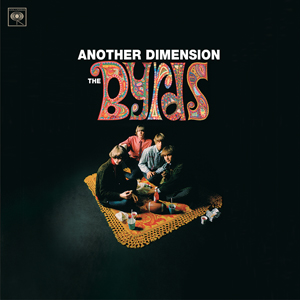

The Byrds - Another Dimension (Fifth Dimension outtakes and alternate versions) (Sundazed 2005)
2x10" Gatefold Set Cat.# SEP210-168 (VINYL-ONLY)
1. Eight Miles High - Instrumental, take 2 (Jan 25, 1966)
2. Why - Instrumental, take 17 (Jan 24, 1966)
3. Ryder (I Know My Rider) - instrumental, take 9 (April 28, 1966)
4. John Riley I - instrumental, take 2 (Feb 21, 1966)
5. 2-4-2 Fox Trot (The Lear Jet Song) - long version, instrumental without sound effects (May 3, 1966)
6. Psychodrama City - instrumental, take 1 (July 28, 1966)
7. John Riley II - complete early master, no string overdubs (May 4, 1966)
8. Wild Mountain Thyme - complete early master, no string overdubs (May 4, 1966)
9. Hey Hoe (Where You Gonna Go) - radio broadcast, stockholm (April, 1967)
10. I See You - complete early master, longer version without overdubs (May 6, 1966)
11. What's Happening?!?! - completed master, long version partial alternate vocal (April 29, 1966)
12. Captain Soul (30 Minute Break) - complete early master, longer version without overdubs (May 6, 1966)
"Now heavily influenced by the earth-shaking creations of two master musicians—John Coltrane and Ravi Shankar - The Byrds began recording their new single, “Eight Miles High” and “Why,” along with tracks for their upcoming album Fifth Dimension at Columbia Studios in Hollywood. Growing more confident by the day in their studio acumen and songwriting skills, the Byrds logged long nights of hypnotic in-studio jamming, then hammered yhe white-hot magma into songs that will live forever. McGuinn’s solos soared as never before, his technique now fusing the familiar, melodic overtones of the Rickenbacker 12-string with a powerfully new staccato dissonance absorbed from the majestic saxophone of John Coltrane. Michael Clarke’s drumming never sounded better, his Elvin Jones-like cymbal splashes and rolling-tom thunder driving the band like an atomic generator approaching critical mass. Chris Hillman’s swooping bass lines took on a McCartney-esque timbre that filled in every corner of the canvas with bold, melodic strokes. But it was perhaps David Crosby, playing in a brashly percussive way no one had ever heard before from a rhythm guitarist, who best digested and interpreted the Eastern influences of the day: the ragas and tablas of Ravi Shankar. Crosby’s contribution to Fifth Dimension was as outspoken and defiant as the man, himself. A creative zenith in the Byrds’career, these fascinating sessions deserve closer scrutiny than they’ve previously been afforded. Alternate instrumental takes and extended experimental workouts give essential insight here into the songs’final versions. Also included are early versions of songs before the addition of any studio “sweetening” — strings, percussion or sound effects. To top things off, we’ve included a small handful of unique finds that give a “fly-on-the-wall” glimpse into the creation of one of the most important records of our time." - Sundazed's heavy-handed sales pitch.
As exquisitely packaged as this release of the Byrds Fifth Dimension outtakes is -- presenting two 10" six-song vinyl EPs in a gatefold sleeve -- Another Dimension is really for collectors only, though it doesn't pretend to be anything else. The first disc offers half-a-dozen instrumental backing tracks of alternate takes, two of them for outtakes that didn't even make the original Fifth Dimension LP. While there are definite differences to be heard (as well as an opportunity to focus on and study the instrumental parts without interference from vocals), most of the tracks aren't radically variant from the familiar official versions, though it's interesting to hear some different lead guitar work on "Eight Miles High" (and a considerably longer solo), as well as a long instrumental version of "2-4-2 Fox Trot (The Lear Jet Song)" without the sound effects. "John Riley I" is not merely a backing track to the "John Riley" song that appeared on Fifth Dimension, however; it's a wholly different, faster, and far more jazz-psychedelicized arrangement, with some quite interesting Roger McGuinn lead guitar work. It's also about a minute longer than the version that appears as a Fifth Dimension CD bonus track; adding all these factors together, it qualifies as the most interesting item excavated by this album, other than the alternate "Eight Miles High" backing track.
Disc two contains noticeable variations rather than wholly different performances, including "John Riley" (the vocal version from the actual Fifth Dimension LP, which is entirely different from the "John Riley I" instrumental) and "Wild Mountain Thyme" without string overdubs; a slightly longer version of "I See You" without overdubs; a longer version of "Captain Soul," again without overdubs; a longer version of "What's Happening?!?!," with a "partial alternate vocal"; and "Hey Joe," recorded not at the Fifth Dimension sessions, but for an April 1967 Swedish radio broadcast. So overall, Another Dimension is the kind of thing you find on bootlegs aimed at highly specialized collectors, but here given an authorized issue, with the top-notch sound quality achieved by using the original tapes. The inner gatefold includes the fascinating transcript of a March 1966 press conference in which Roger McGuinn and David Crosby discuss the raga-rock pioneered on the Byrds' "Eight Miles High"/"Why" single; it's actually the most interesting thing about this release.